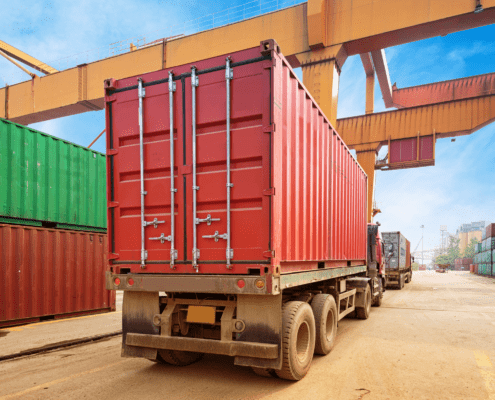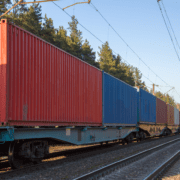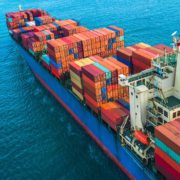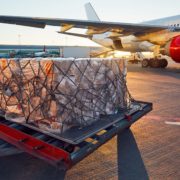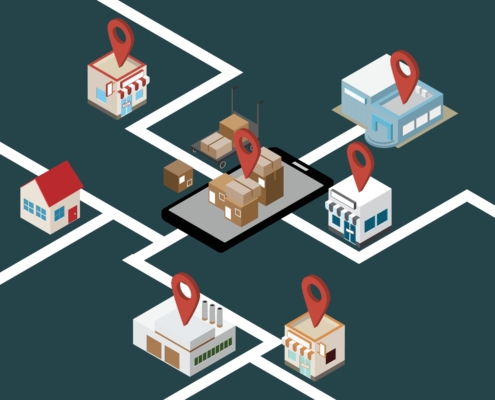Intermodal Means of Transportation
Let’s take a closer look at the modes of transportation most often used in intermodal shipping.
Trucking
Truckload shipping plays a crucial role in intermodal freight shipping, from the first to the last mile and in transporting shipments between modes, also referred to as drayage. Trucks used for intermodal shipping are often specialized vehicles, such as trucks that use a chassis designed to efficiently transport shipping containers, refrigerated trucks for handling perishable goods, and flatbeds for transporting oversized cargo. Over-the-road (OTR) shipping via trucks provides an efficient, flexible, and agile option for transporting goods. Less-than-truckload (LTL) is sometimes used to consolidate smaller shipments into a single container for intermodal shipping.
Rail Transport
Rail is a cost-effective and efficient option for intermodal transportation. Because rail lines require longer transit times as compared to modes such as air or over the road, it is ideal for cargo that is not particularly time sensitive. Rail transport is considered a highly reliable option as it is less susceptible to delays caused by traffic congestion and weather delays. In addition, rail transport emits fewer greenhouse gases per ton of freight as compared to trucks, so it provides a more sustainability-focused option.
There are several types of railcars that are commonly used for intermodal shipping:
- Well Cars: Also known as double-stack cars, well cars are designed for the transport of stacked containers.
- Flat Cars: Flat cars are simply a platform, without sides or roof, for transporting oversized or heavy loads.
- Spine Cars: These cars have a central “backbone” for mounting containers and trailers.
- Refrigerated Cars: Also known as “reefers,” refrigerated cars are equipped with refrigeration units to maintain goods at a specific temperature.
- Tank Cars: These cylindrical cars are used for transporting liquids and gases.
- Boxcars: These enclosed railcars are used for goods that need to be protected from the elements but do not require containerization.
- Hopper Cars: Hopper cars carry bulk commodities such as grains, coal, or ore and feature sloping floors and discharge doors that facilitate unloading.
Ocean Shipping
Ocean shipping is utilized for international shipments and is ideal for transporting large volumes of goods great distances. Standardized ocean shipping containers, also called intermodal containers, ISO containers, or TEUs (twenty-foot equivalent units), make the transfer of shipments from ships to trucks to rail efficient and consistent. Ocean shipping can be highly cost-effective, efficient, and environmentally friendly as compared to trucking, however, transit times are considerably longer than other forms of international transportation, such as air freight.
Air Freight Transport
Air freight is an attractive option for high value, low volume goods (such as electronics and luxury items), products that are particularly time-sensitive (such as pharmaceuticals, emergency supplies, perishables, and critical parts and components) and sensitive items (such as legal and financial documents). Air freight utilizes unit load devices (ULD) which are standardized to fit inside the circular cargo hold of aircraft. These containers are significantly smaller than TEU’s used for ocean shipping.
How Does Intermodal Trucking Work?
Successfully utilizing intermodal shipping requires the seamless orchestration of multiple modes of transportation. Here’s what the typical intermodal shipping process looks like from end-to-end:
Origin and Packaging
The goods are produced, packaged and loaded into standardized containers in preparation for intermodal transport.
Truck to Intermodal Ramp
The container is picked up from the point of origin and loaded onto a truck, typically by a drayage service, which transports the container to an intermodal ramp (this could be a rail yard or port).
Cargo Transfer
Upon arrival at the rail yard or ramp, the container is transferred to a rail chassis or ship. Moving the large and heavy containers requires cranes or reach stackers, specialized equipment designed for this purpose.
Long-Haul Transportation
Whether the container is loaded onto a train or a ship, this step represents the long-haul portion of the shipment’s journey.
Intermodal Ramp Back to Truck
After its lengthy rail or ocean journey, the container arrives at an intermodal ramp and is unloaded, picked up by a drayage company, and transported to its final destination ( a warehouse, distribution center, retail store or other location).
What Are the Benefits of Intermodal Shipping?
Shippers choose intermodal shipping to take advantage of a variety of benefits:
Cost Effectiveness
By taking advantage of the strengths of different transportation methods, shippers can combine truck, rail and ocean shipping to lower overall transportation costs. In addition to lower base shipping rates, rail and ocean shipping also offer greater fuel efficiency as compared to trucking, leading to lower fuel costs.
Fuel Efficiency Creates Environmental Benefits
In addition to lower fuel costs, ocean and rail shipping also offer environmental benefits in the form of lowered greenhouse gas emissions and reduced carbon footprint as compared to trucks.
Reliability
Rail and ocean transportation providers operate on fixed schedules that can provide greater certainty when compared to the variability inherent to over the road transportation. Utilizing rail or ocean transportation can avoid long delays associated with road constructions, traffic congestion or severe weather. However, as recent events such as the container ship Ever Given running aground and blocking the Suez Canal or attacks by Houthi rebels on Red Sea shipping have shown, ocean and rail transport are not immune to disruption.
Tracking
Intermodal shipments transit entire oceans, cross international borders, and are routinely on- and offloaded several times across multiple modes on their journey. Real-time tracking is essential to maintaining visibility to shipments while in transit, predicting ETAs, and mitigating potential delays. Modern real-time tracking methods are integrated with TMS platforms and can track down to the container level to provide the real-time visibility shippers need.
Increased Capacity
Both ocean and rail shipping offer shippers the ability to move large volumes of goods, which minimizes the number of individual shipments and creates economies of scale.
What Items are Suitable for Intermodal Shipping?
The intermodal shipping market is expected to grow at a brisk clip CAGR of 16.2% to $136B by 2030. Part of this growth is due to the compatibility of intermodal freight transportation to a wide variety of goods:
Intermodal Transportation Examples
Now that we’ve explored how intermodal transportation works, let’s look at a few real-world examples of how it is used in various industries. Have you ever wondered how that new QD-OLED TV made its way from the manufacturer to your living room in time for the Super Bowl? Or how fresh cut flowers are transported from South America to the U.S. for Mother’s Day? Read on.
Electronics
- A global electronics retailer sources product from manufacturers located in China
- The electronics are manufactured, loaded into containers, and shipped by truck to the nearest port, where they are loaded onto a container ship.
- The ship sets sail for the West cost of the U.S., where the containers are unloaded.
- At this point, some of the containers are loaded onto trucks for transport to distribution centers. The rest of the containers are loaded on rail for transport cross-country to distribution centers. At the distribution centers, the containers are unpacked, and the goods are stored while awaiting transportation to their destination via truck.
- The entire intermodal shipping process can take 20-30 days.
Fresh cut flowers
- Farms in Colombia and Ecuador grow many of the fresh-cut flowers that are shipped to the U.S. After harvesting, the flowers are sorted, trimmed, and packaged in specially designed boxes that retain moisture and maintain the proper temperature to ensure freshness.
- The packaged flowers are then loaded into refrigerated trucks (also known as reefers) and transported to the airport, where they are transloaded in the refrigerated cargo holds of airplanes. The flowers are then flown to Miami, which is a key hub for imported flowers.
- The flowers then go through customs, where they are inspected for pests and diseases.
- Upon clearing customs, the flowers are loaded back onto trucks and transported to an intermodal terminal such as a rail yard.
- The flowers are loaded onto refrigerated rail cars for cross country transportation across long distances.
- Once the flowers reach their destination rail terminal, they are loaded onto refrigerated trucks for transport to distribution centers, wholesales, or directly to supermarkets and florists.
- The flowers are then delivered to local stores or directly to consumers.
- Altogether, the entire harvesting and transportation process takes just 4-7 days. Many of the steps are expedited to ensure freshness.
Intermodal shipping powers the global economy, combining the strengths of various modes of shipping to efficiently and cost-effectively transport goods across oceans and continents. By leveraging the benefits of intermodal shipping, businesses can optimize their supply chains, reduce environmental impact, and meet the demands of an increasingly globalized market. Is intermodal service right for your goods? Please contact Sheer Logistics today to learn more.


